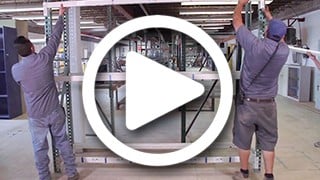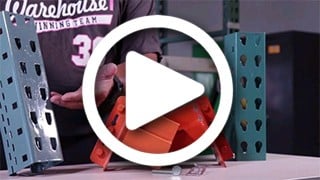10 Ways to Improve Your Warehouse Security
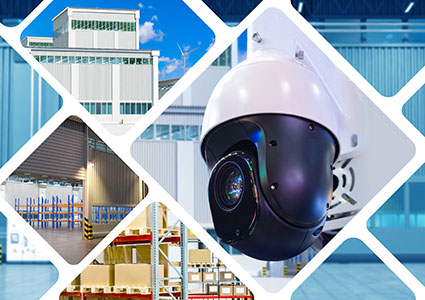 Inventory shrinkage is a huge issue in modern warehousing. This occurs when inventory is lost before it reaches the intended customer. Not only can this have a huge impact on a company’s bottom line, it can also contribute to SKUs out of stock or incorrect orders—issues that tend to erode trust among consumers.
Inventory shrinkage is a huge issue in modern warehousing. This occurs when inventory is lost before it reaches the intended customer. Not only can this have a huge impact on a company’s bottom line, it can also contribute to SKUs out of stock or incorrect orders—issues that tend to erode trust among consumers.
Common estimates indicate that businesses suffer shrink rates of between 1 and 2 percent every year, with the National Retail Security Survey 2023 revealing a shrink rate of 1.6 percent in 2022—accounting for over $112 billion in losses. Many concerns contribute to these high shrink rates, but theft is one of the most commonly cited issues.
Whether it occurs externally (such as break-ins) or internally (employee theft), these issues must be tackled proactively to keep vulnerable inventory, facilities, and warehouse workers safe. This begins with developing comprehensive security solutions. No one feature or policy can guarantee a secure warehouse, but a layered approach can make all the difference.
Below, we have highlighted a few of the most important warehouse security measures and how they play into the bigger picture of shrinkage prevention.
1. Conduct a Security Audit
 Security weaknesses cannot be properly addressed until they are known. Comprehensive security audits reveal blind spots while also demonstrating how these issues limit progress towards key business objectives—and which solutions might be most effective.
Security weaknesses cannot be properly addressed until they are known. Comprehensive security audits reveal blind spots while also demonstrating how these issues limit progress towards key business objectives—and which solutions might be most effective.
Every audit should include a thorough overview of existing physical security infrastructure. This means examining several of the security essentials that we will describe in more detail below, such as gates, fences, locks, surveillance cameras, and even lighting.
Audits should also touch on inventory management strategies, ensuring that current strategies promote accurate tracking. Make sure to not forget about cybersecurity concerns too; an audit should help identify vulnerabilities within digital systems to help prevent data breaches.
2. Install Surveillance Systems
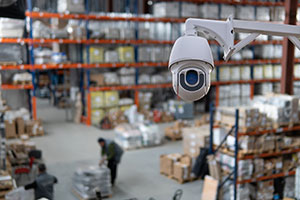 Surveillance systems provide real-time monitoring capabilities, with footage easily retrieved and reviewed in the event of a break-in. When security cameras are visible, they may also act as a deterrent; would-be thieves may be less likely to move forward with criminal activities if they think they are being monitored.
Surveillance systems provide real-time monitoring capabilities, with footage easily retrieved and reviewed in the event of a break-in. When security cameras are visible, they may also act as a deterrent; would-be thieves may be less likely to move forward with criminal activities if they think they are being monitored.
Another advantage worth considering: inventory tracking. Cameras can be strategically placed throughout the warehouse to reveal the movement of goods within this environment. These cameras may go beyond basic alarm systems by integrating with radio-frequency identification (RFID) systems for enhanced inventory management.
3. Implement Access Control Systems
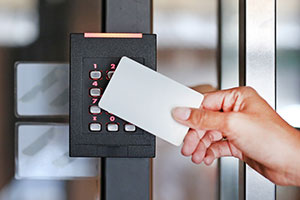 Access control systems ensure that only authorized individuals (such as warehouse workers) enter facilities. These assign various levels of access, allowing certain people to enter and navigate warehouses but setting strict limits regarding where and when. These systems could feature PIN numbers, key cards, or even biometric scanners.
Access control systems ensure that only authorized individuals (such as warehouse workers) enter facilities. These assign various levels of access, allowing certain people to enter and navigate warehouses but setting strict limits regarding where and when. These systems could feature PIN numbers, key cards, or even biometric scanners.
This approach also improves traceability, which can prove valuable in the event of a security incident. Instead of relying exclusively on footage captured by surveillance systems, companies with strong access control can reveal who was in the warehouse at any given time—and who was authorized to be there.
4. Use Security Cages and Wire Partitions
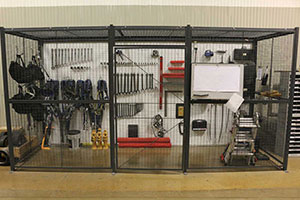 As robust, protective enclosures, security cages safeguard high-value items that would otherwise be vulnerable to theft. These lockable structures provide powerful physical protection and are among the most reliable security solutions. It is not only incredibly difficult for external criminals to access items stored within these cages but also challenging for unauthorized employees.
As robust, protective enclosures, security cages safeguard high-value items that would otherwise be vulnerable to theft. These lockable structures provide powerful physical protection and are among the most reliable security solutions. It is not only incredibly difficult for external criminals to access items stored within these cages but also challenging for unauthorized employees.
Security cages are often found in storage areas, but some are situated near high-traffic areas for easy access and theft deterrence. Others may be found near offices or entry points.
Additional storage and security infrastructure may also be worth considering. Mesh wire petitions provide a lower-cost alternative to security cages but can also assist with organizing, separating, or storing essential items. They provide excellent visibility and can serve many functions beyond security, including extra protection for mezzanines.
5. Enhance Physical Barriers
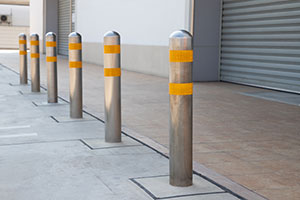 Access control may cover main entry areas, but there are many other ways for criminals to enter seemingly secure warehouses. Windows, for example, can be surprisingly easy for sophisticated criminals to break into.
Access control may cover main entry areas, but there are many other ways for criminals to enter seemingly secure warehouses. Windows, for example, can be surprisingly easy for sophisticated criminals to break into.
Ideally, warehouse windows will be situated high enough to limit access and may also feature covers, steel bars, locking mechanisms and other implements designed to deter unauthorized individuals. Some warehouses use glass blocks, as these allow natural light to flow through but are far more resistant to impact than conventional windows.
Top strategies for dealing with unauthorized vehicle access include bollards and barriers. Swinging, sliding, or pivoting gates can be helpful, as can active solutions with moving components: drop-arm barriers, for example, direct traffic, while wedge barriers (also known as pop-up barriers) spring up from the surface as needed to form a wedge shape.
6. Improve Lighting
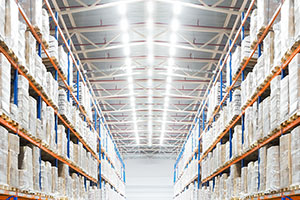 Lighting plays a crucial role in promoting both safety and security throughout the warehouse environment. Crimes are simply more difficult to carry out when perpetrators are unable to fully conceal themselves. Combined with surveillance systems and access control strategies, proper warehouse lighting can allow for quick identification.
Lighting plays a crucial role in promoting both safety and security throughout the warehouse environment. Crimes are simply more difficult to carry out when perpetrators are unable to fully conceal themselves. Combined with surveillance systems and access control strategies, proper warehouse lighting can allow for quick identification.
High-quality lighting is also important because it improves accuracy, productivity, and warehouse safety. Employees who work in well-lit areas are less likely to trip or collide with unseen objects. Many warehouses rely on high bay lights, which are mounted at significant heights and may take on linear shapes (for narrow aisles) or round shapes for open areas.
Entry points and parking lots should also be well-lit, as this may deter would-be criminals from attempting to access the warehouse in the first place. Floodlights are among the most versatile and reliable fixtures for these settings.
7. Hire Security Personnel
 Automated solutions can be helpful, but there is no substitute for well-trained security officers. Tasked with conducting regular patrols, these professionals take their work seriously and bring a wealth of knowledge regarding security risks, preventative measures, and even regulatory compliance.
Automated solutions can be helpful, but there is no substitute for well-trained security officers. Tasked with conducting regular patrols, these professionals take their work seriously and bring a wealth of knowledge regarding security risks, preventative measures, and even regulatory compliance.
Should unauthorized individuals attempt to gain access to off-limits areas, security officers can physically prevent them from entering or coordinate with law enforcement if necessary. Many handle visitor management, which may involve verifying credentials or even conducting checks (via metal detectors or scanners) to keep contraband items out of the warehouse.
8. Implement Cybersecurity Measures
 Many organizations implement well-rounded physical security measures but neglect to safeguard digital systems and information. These solutions are just as important, however, especially given the increased reliance on warehouse management systems (WMS) and enterprise resource planning (ERP).
Many organizations implement well-rounded physical security measures but neglect to safeguard digital systems and information. These solutions are just as important, however, especially given the increased reliance on warehouse management systems (WMS) and enterprise resource planning (ERP).
Strong data encryption is essential, along with digital authorizations or controls that follow the principle of least privilege: users should be granted the minimum level of permission necessary to carry out essential digital tasks. Firewalls and intrusion detection (and prevention) provide additional safeguards, and, in the worst-case scenario, backup solutions can minimize downtime.
9. Conduct Regular Employee Trainings
 Employees should be on the front lines of maintaining warehouse security. This is best achieved through regular training, with the goal of improving awareness so that employees recognize signs of crime while also abiding by critical security policies and procedures.
Employees should be on the front lines of maintaining warehouse security. This is best achieved through regular training, with the goal of improving awareness so that employees recognize signs of crime while also abiding by critical security policies and procedures.
Training should also emphasize accurate inventory management as deficits in this area can exacerbate shrinkage or even directly cause it. Employees who deal with WMS and other digital systems should receive cybersecurity training so that they can recognize signs of breaches, including attempts to launch phishing attacks.
10. Use Inventory Management Systems
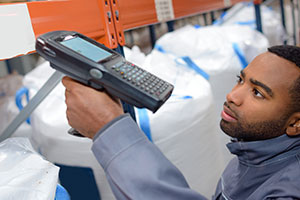 While some breaches may trigger alarms or arouse suspicion among security officers, many situations involving shrinkage are far more difficult to detect. This is particularly complicated when employees or other authorized individuals engage in illegal activities. In these situations, unexplained issues with inventory may be the first signs of security weaknesses.
While some breaches may trigger alarms or arouse suspicion among security officers, many situations involving shrinkage are far more difficult to detect. This is particularly complicated when employees or other authorized individuals engage in illegal activities. In these situations, unexplained issues with inventory may be the first signs of security weaknesses.
Prevent shrinkage by conducting regular stock checks and performing in-depth audits. Should discrepancies emerge, these should be promptly reported and investigated.
Improve Your Warehouse Security Storage
No single solution will prevent warehouse theft or shrinkage, but a strategic blend of the best tools, technologies, and policies can provide powerful deterrence. Aim for a well-rounded warehouse security system that acknowledges the many potential sources of inventory shrinkage.
Don't forget about physical barriers, which, although not as seemingly sophisticated as some of the high-tech solutions discussed above, remain an important part of overall security.
Security is a priority for our team at Warehouse1. This is an important consideration when we provide layout consultations, lighting surveys, and reconfiguration services. Feel free to shop our security products, including safety cages, partitions, and more. Reach out for more information or to request a quote.
